#Arachnology
Explore tagged Tumblr posts
Text
Strange Bedfellows: these unprecedented photos show a leafcutter bee sharing its nest with a wolfspider

I stumbled across these photos while I was looking for information about leafcutter bees, and I just wanted to share them, because they're really remarkable. The images were captured by an amateur photographer named Laurence Sanders, and they depict an unprecedented scene that has garnered the attention of both entomologists and arachnologists.

The photos show a leafcutter bee and a wolfspider living in the same burrow.
The leafcutter bee (Megachile macularis) can be seen fetching freshly-cut leaves, which she'll use to line the inner walls of her nest, while the wolfspider sits at the entryway to the burrow; as the bee approaches, the wolfspider moves aside, allowing her to enter the nest, and then she simply watches as the leaf is positioned along the inner wall.

Once the leaf is in position, the bee and the spider seem to inspect the nest together, sitting side-by-side in the entryway. The leafcutter bee seems strangely at ease in the presence of the wolfspider, which is normally a voracious predator, and the wolfspider seems equally unfazed by the fact that it shares its burrow with an enormous stinging insect.

The man who took these photographs discovered the peculiar scene by accident, and he then captured a series of images over the course of about two days (these are just a few of the photos that were taken). During that two-day period, the bee was seen entering the nest with bits of foliage dozens of times, gradually constructing the walls and brood chambers of its nest, and the spider was clearly occupying the same burrow, but they did not exhibit any signs of aggression toward one another.

The photos have been examined by various entomologists and arachnologists, and those experts seem ubiquitously surprised by the behavior that these images depict. The curator of entomology at Victoria Museum, Dr. Ken Walker, noted that this may be the very first time that this behavior has ever been documented, while Dr. Robert Raven, an arachnid expert at the Queensland Museum, described it as a "bizarre" situation.
This arrangement is completely unheard of, and the photos are truly remarkable.
Sources & More Info:
Brisbane Times: The Odd Couple: keen eye spies bee and spider bedfellows in 'world-first'
iNaturalist: Megachile macularis
#entomology#arachnology#leafcutter bee#wolfspider#symbiosis#cool animals#cool bugs#bees#spiders#nature#cute#insects#arachnids#australia#props to the photographer#laurence sanders#this is a cute couple#but their babies would be terrifying
26K notes
·
View notes
Text
orb weavers' sexual dimorphism is hilarious to me like.
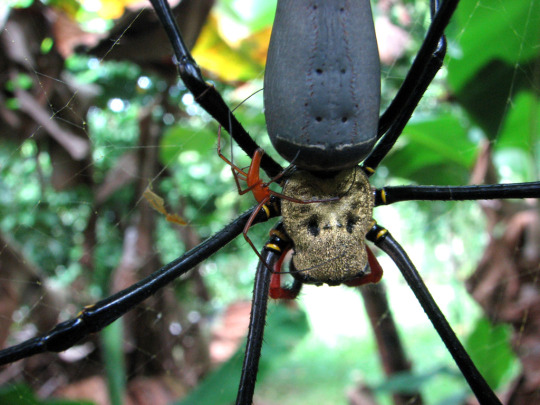
me and my big beautiful wife
#northern golden orb weaver#spiders#arachnids#ecology#bugblr#Nephila pilipes#arachnology#zoology#nature#australia
16K notes
·
View notes
Text
Just a girl and her bundle of baby clones she's wearing like an ass turban 🥹
My population of Schizomida (parthenogenic tailless whipscorpions) are so happy in their box of dirt. As always, tending a box of dirt is such a good decision and I recommend it.

#nature#animals#bugblr#photography#invertebrates#science#arachnology#Invertebrate parenthood#schizomida
1K notes
·
View notes
Text

Meet the velvet mite! Topsoil, the thin uppermost layer of Earth’s crust, is enriched by innumerable species of invertebrates, like this velvet mite of the family Trombidiidae. This arachnid lives in topsoil and breaks down dead plant and animal matter. Human agriculture, and the survival of virtually all plant species, depends on continuous renewal of topsoil by billions of tiny organisms like mites, roundworms, and termites.
Photo: anthonypaul, CC BY-NC 4.0, iNaturalist
675 notes
·
View notes
Text
Dr. Stark, entomologist
In fact, since childhood, Tony Stark dreamed of becoming an entomologist.


And he made his dream come true:
Studies an arachnid for 6 months before approaching it

Puts a tracker on it

Observes it in its natural habitat
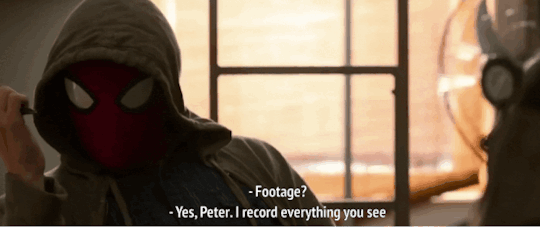
#marvel#mcu#tony stark#iron man#captain america civil war#spider man homecoming#peter parker#spider man#morgan stark#harley keener#entomology#arachnology#irondad
218 notes
·
View notes
Text
Poecilotheria metallica
Is also known as peacock tarantula. It is an Old World species of tarantula. It is the only blue species of Poecilotheria. The species is critically endangered. While it is young the spider is less chromatic and the coloring turns to blue as it matures.




When full size the leg span of the peacock tarantula is 15-20 cm (6-8 in). In the wild it lives in holes of tall trees where it makes asymmetrical funnel webs. The primary prey consists of various flying insects. It is a photosensitive species. There hasn’t been a recorded human death from its bite.


The Venom may produce a heart-rate increase followed by sweating, headache, stinging, cramping or swelling. Effects can last for up to a week. Extreme bites from the genus may still be felt months later.
#spiders#arachnids#arachnology#biology#blue animals#blue spiders#Poecilotheria#cute spider#interesting facts#interesting#animals#science#nature#aesthetic
151 notes
·
View notes
Text
FORMLINE SCORPION 🦂🌃

This piece was done as a contest entry for a local contest that unfortunately did not win. Because of that, I feel comfortable sharing it here. This was a pretty experimental piece and I'm pretty satisfied with how it turned out.
This piece in question was based off the Northern Scorpion (Paruroctonus boreus), which is the only species of scorpion that lives in Canada and also known to glow a bright blue under UV light. (pictured below)
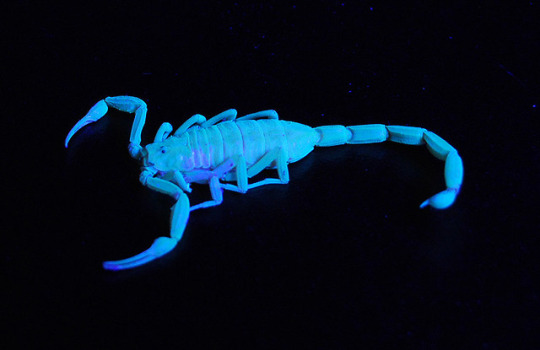
I'm kinda sad I didn't win, but I'm still proud of how the piece turned out. (Also this piece got finished around the end of October last year, so it's been on the backburner in terms of posting for a while lmao)
#cw insects#cw arachnid#formline art#indigenous art#native art#telekitnetic art#scorpion#northern scorpion#arachnology
736 notes
·
View notes
Text



Bark spiders (Caerostris spp.) by Chien C Lee on Flickr, originals at flic.kr/p/2kHkm3J & flic.kr/p/2qqA9zG & flic.kr/p/2kJQyGW. (Posting images directly here so I can add alt text.)
This week I was distraught - genuinely fkn mortified - to discover that my lovely other half, my beloved Kitty the cat-human, doesn't... I mean truly *does not*... Think that bark spiders are friggin adorable.
I weep, OMFGs.
Like. I know I should just be happy that they've come to a point where they evict spiders with a cup & card, instead of squishing them.
But bark spiders.
I mean.
Bark spiders are so cool! They look like bark, FFS.
Look at these bark spiders. Behold them! These fancy spood ladies. The twiggy lookin butts. Their smol faces. Glorious weirdos, how could you be mean to a tiny mush like that? The females only get to a couple of centimetres apparently, males are much smaller. They're soo smol, it's not like they're gonna hurt you Kitty? I mean... Look how anxious they look hugging their twigs?? (Gestures at the world) I feel you, little buddies.
I know they're not the most elegant spoods in webs or wombling around, but they are good cryptic critters, pls be nice to them.
#spider#spiders#arachnid#arachnids#bugblr#arachnida#bark spider#orb weaver#bug#bugs#cool bugs#a beautiful friend#entomology#arachnology#cw spiders#cw spider#cw bugs
87 notes
·
View notes
Text


female and male Western Black Window (Latrodectus hesperus), Northern California
192 notes
·
View notes
Text
Can spider eggs be preserved cryogenically similarly to human eggs
Asking for a friend
54 notes
·
View notes
Text

63 notes
·
View notes
Text
Brenthia Moths: these moths can mimic the appearance and mannerisms of a jumping spider so convincingly that actual jumping spiders will sometimes attempt to court them

The markings, posture, and movements of a Brenthia moth (genus Brenthia, also known as a metalmark moth) all contribute to its disguise; the moths move around in short, jerky motions that mimic the movements of a jumping spider, and their hindwings are covered in black-and-white bands that strongly resemble the tucked-in legs of a salticiid spider, especially when the moth displays its unique wing position. The disguise serves as a defensive strategy, enabling the moth to avoid being preyed upon by actual jumping spiders.

In some cases, that disguise may work a little too well, as jumping spiders may actually mistake the moth for a potential mate and then attempt to engage it in a courtship/mating dance (which must be a pretty awkward and bizarre experience for the moth, tbh).
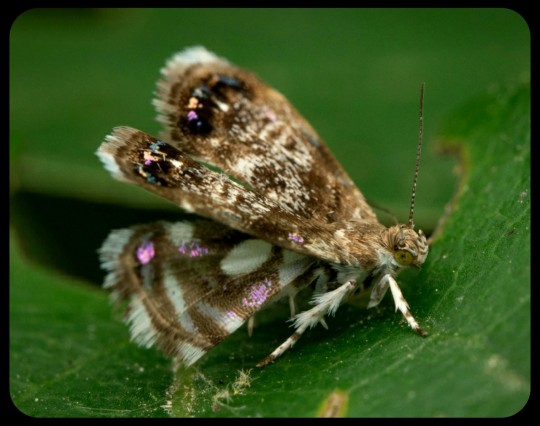
The resemblance between a Brenthia moth and a jumping spider may not seem terribly convincing to us, as human beings, but as this article explains:
When discussing animals mimicking their predator, it is important to remember that we humans are not the target audience. This means that the imitator may not look too convincing in its mimicry to us, but still manages to trigger a desired response from said predator.
Jumping spiders have also been known to respond to Brenthia moths by exhibiting a territorial display, which is yet another behavior that the spiders generally reserve for other spiders.
This study expands on the adaptive benefits of the moth's disguise:
In controlled trials, Brenthia had higher survival rates than other similarly sized moths in the presence of jumping spiders and jumping spiders responded to Brenthia with territorial displays, indicating that Brenthia were sometimes mistaken for jumping spiders, and not recognized as prey.
The illustration below shows the basic/general resemblance between a Brenthia moth and a jumping spider:

Sources & More Info:
New Scientist: Moth's Disguise is so Good, Spiders Love it Instead of Eating it
Animal Behaviour: Sheep in Wolf's Clothing
Science: This Moth Could Pass for a Spider
PLOS ONE Journal: Metalmark Moths Mimic their Jumping Spider Predators
Gil Wizen: Jumping Spider Mimicry in Brenthia Moths
Moths of North Carolina: Brenthia pavonacella
#lepidoptera#entomology#moths#peacock moth#brenthia#metalmark#mimicry#animal camouflage#cool animals#insects#cute bugs#jumping spiders#animals#arachnology#spiders#animal facts#salticidae#arthropods#mimicry among moths
6K notes
·
View notes
Text
It's been a long day.
You're exhausted.
And while your eyes are usually incredibly sharp, for this ability, your ancestors traded away every. last. scrap. of night vision.
Nevertheless, the dark is full of predators. So, on the underside of a leaf, a Lyssomanes jumping spider mom remains awake, vigilantly listening and feeling for any threats to her spiderlings.

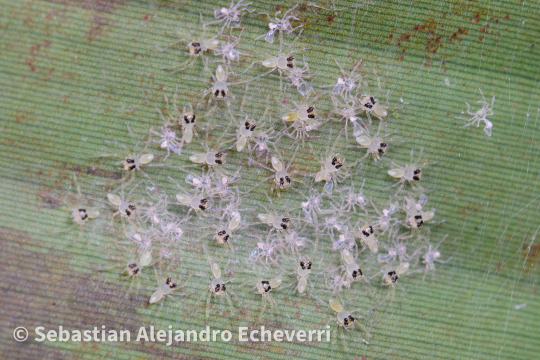
(this is part of @franzanth's Insert An Invert project, meant to get y'all curious about bugs and other Invertebrates, so you try including em in your art. February's theme is "Relationships")
#insert an invert#now be inspired and go draw spiders#jumping spiders#id in alt text#bugs#cw spiders#invert_macro#arachnology#wildlife#nature
330 notes
·
View notes
Text
I've seen so many of our Centruroides hentzi scorpions over the years, but somehow never a mother carrying her tiny pinchy children until today. Invertebrate parenthood is so sweet. 🤎🤎


2K notes
·
View notes
Text

When this spider eats, “glitter” comes out.✨Meet the black-spotted thwaitesia (Thwaitesia nigronodosa)! It sequesters a silvery chemical compound, called guanine, during digestion. Found in parts of southern Australia, this shimmering arachnid is a member of the genus thwaitesia; members of this genus are also known as sequined spiders or mirror spiders, thanks to their sparkly appearance! Scientists think these colorful displays are actually a form of camouflage.
Photo: nicklambert, CC BY-NC-SA 4.0 iNaturalist
#nature#natural history#animals#fact of the day#did you know#spiders#glitter#cool animals#arachnids#arachnology#entomology#fun facts
1K notes
·
View notes
Text

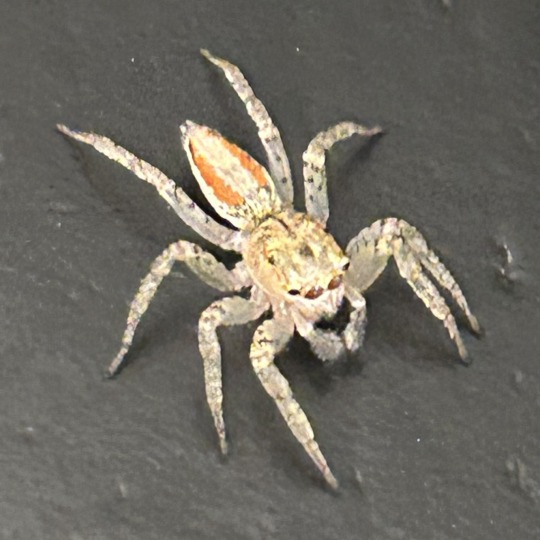

Bugs from the past few days
#entomology#arachnology#bug identification#six spotted tiger beetle#cicindela sexguttata#dimorphic jumping spider#maevia inclemens#campaea#geometer moth#not art#bugposting#bug cw#spider cw
26 notes
·
View notes